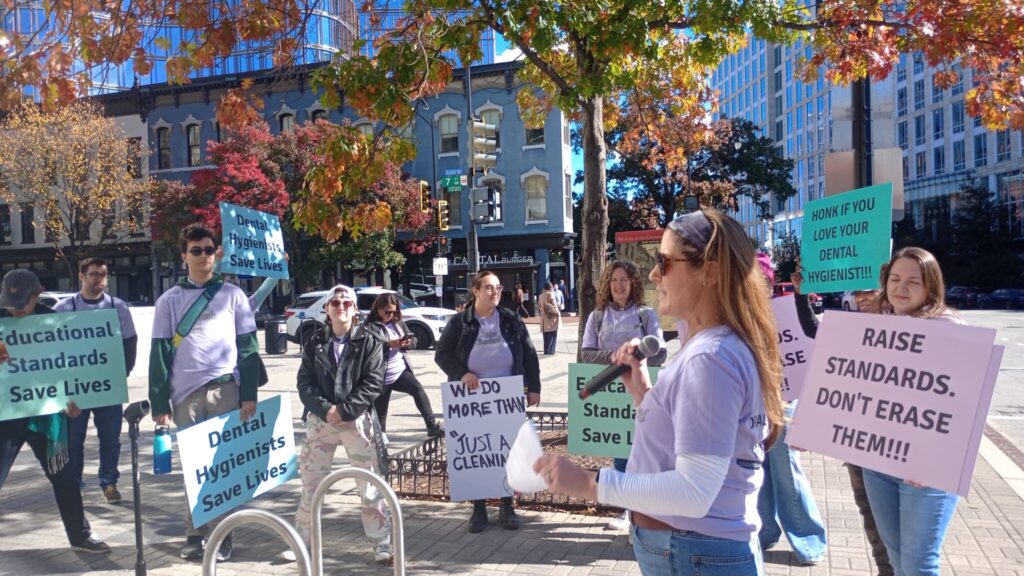
“Educational standards save lives,” and “Raise standards, don’t erase them,” read the signs carried by about 50 dental hygienists who gathered in Washington, D.C., on Oct. 25.
The demonstration, organized by the non-profit Oral Health Awareness Projec (OHAP), took place during the American Dental Association’s SmileCon and 2025 House of Delegates meeting to bring wider attention to the issue. The group, officially formed in June 2025 after gaining traction on social media, aims to oppose efforts they say would lower or bypass the Commission on Dental Accreditation (CODA)’s nearly 3,000-hour educational requirement for dental hygienists—typically completed through a two-year associate’s or four-year bachelor’s degree.
Although the rally was primarily made up of dental hygienists, a number of dentists and public policy students also attended, according to organizers.
“We even had dentists come out to meet with us,” said Lisandra Maisonet, BS, RDH, PHDHP, EFDA, executive director of OHAP. “They told us they’re on our side when it comes to protecting educational standards.”
“OHAP began as a movement — hygienists from across the U.S. coming together online to defend educational standards and protect patients,” Maisonet added. “We’re not a union or an association; we’re a collective voice saying, ‘our patients deserve care from fully educated professionals.’”
Maisonet said OHAP’s purpose is to educate both legislators and the public on the preventive and diagnostic expertise dental hygienists bring to patient care.
“We weren’t created to compete with the American Dental Hygienists’ Association,” she said. “OHAP exists to protect patients — to make sure the people caring for them have the right education and training. The ADHA represents our profession; we’re focused on protecting the public.”
Workplace factors behind the so-called shortage
Both the American Dental Association (ADA) and the ADHA have acknowledged a shortage of practising dental hygienists in the United States. The ADHA’s 2024 workforce position statement notes that 24.7 million Americans live in dental-care shortage areas, while 1.7 million cannot access care within a 30-minute drive, and that periodontal disease costs $154 billion annually in lost productivity.
Last year, the ADA passed a resolution allowing foreign-trained dentists to work as dental hygienists — a move rejected by the ADHA, which submitted written testimony to CODA opposing changes that would let internationally trained providers bypass accredited programs.
Related: Hygienists push back on call to allow foreign-trained dentists to provide preventive care
Related: Record numbers: 2024 is the highest in five years for foreign-trained dentists immigrating to Canada
Proposals have continued. Nevada’s Senate Bill 495, which would have permitted licensure without CODA accreditation, failed earlier this year following opposition from the ADHA and the Nevada Dental Hygienists’ Association. In October, the ADHA’s board reaffirmed support for CODA-accredited education and rejected any “preceptor training” or Alabama Dental Hygiene Program (ADHP)-type pathways that circumvent those requirements. The ADHP remains the only non-CODA route to licensure in the U.S.
Maisonet said such proposals miss the real issue.
“I don’t believe we’re facing a true shortage of dental hygienists — we’re facing a shortage of good working conditions,” she said. “If more practices offered benefits, paid vacation and a supportive environment, we’d see many hygienists return to the chair.”
“There are more than 200,000 licensed dental hygienists in the U.S.,” she added. “The problem isn’t numbers — it’s that many leave private practice because they don’t receive benefits, paid time off or respect for their clinical expertise. If dental offices improved working environments and treated hygienists as integral members of the care team, we’d solve much of the so-called shortage overnight.”

The risk of inconsistency
Anne O. Rice, RDH, BS, FAAOSH, CDP, a member of OHAP’s 22-member task force, said patient safety is at the heart of the group’s concerns.
“When alternative licensing models for dental hygienists are introduced, the greatest risks to patient care often come from inconsistency,” Rice said. “Our profession was built on a strong foundation of education, clinical competency and licensure standards designed to protect the public. If those benchmarks are diluted or vary widely from state to state, we risk creating confusion for patients — and even among providers — about what services can safely be delivered.”
She added that inadequate training pathways could lead to “fragmentation of care,” affecting accountability and continuity in diagnosis and prevention.
“Why invest in the education, debt and responsibility of becoming a licensed dental hygienist if anyone can perform the same services with less preparation?” she asked. “High standards attract high talent. If we want sustainable practices, we need to protect the value of professional education — not undermine it.”
Related: From scaler to spatula: Why dental hygienists aren’t quitting the profession—but the workplace
Related: U.K. dental group: Foreign-trained dentists should work in clinics, not McDonald’s
‘Front line of preventive medicine’
Another OHAP board member Melissa Obrotka, BA, RDH, ICP Coach, said the movement underscores how dental hygiene is central to whole-body health.
“Dental hygiene is the front line of preventive medicine,” Obrotka said. “In the chair, we don’t just scrape and polish enamel; we detect inflammation, infection and early signs of systemic disease that can change the course of someone’s health. That responsibility demands accredited education, evidence-based training and clinical excellence. Diluting those standards risks more than public trust — it risks lives.”
Maisonet said the D.C. rally marks just the beginning.
“We’re building an army of hygienists ready to speak to legislators, educate their patients and stand up for the standards that protect public health,” she said. “This isn’t about competition — it’s about collaboration and integrity in patient care.”